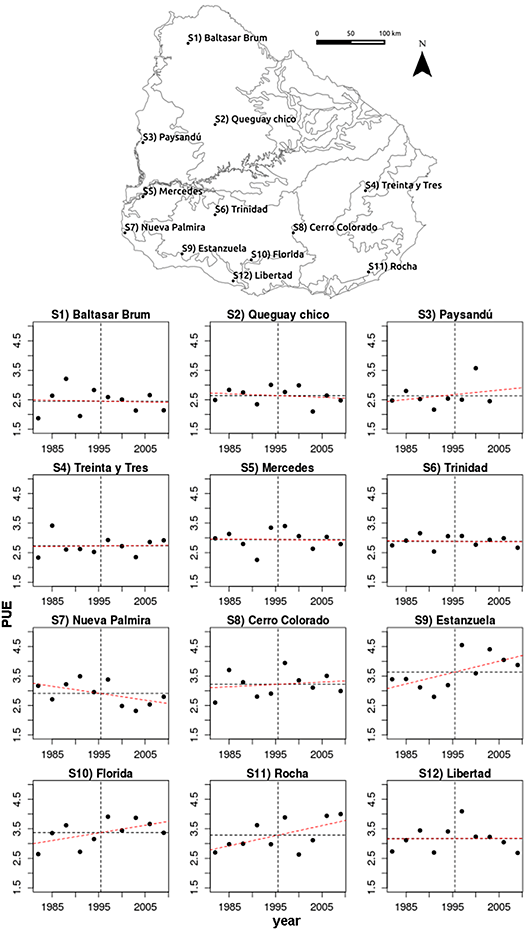
Ecological Archives C006-055-A3
Marcos Texeira, Mariano Yarzabal, Gervasio Pineiro, Santiago Baeza, and Jose Maria Paruelo . 2015. Land cover and precipitation controls over long-term trends in carbon gains in the grassland biome of South America. Ecosphere 6:196. http://dx.doi.org/10.1890/es15-00085.1
Appendix C. Trends in integrated precipitation use efficiency and precipitation marginal response.
In this appendix we show the results of the trend analyses for 3 and 5 year integrated precipitation use efficiency. We also show the patterns of precipitation marginal response for the subset of 12 ground meteorological stations with precipitation records from 1948 to 2011 and fPAR estimates from 1981 to 2011.
Table C1. Results of the regressions of 3 year integrated precipitation use efficiency against time for twelve sites with precipitation and fPAR records for the period 1981 to 2011. For each site the most parsimonious models according to Akaike information criterion is shown. “b1” represents the slope of the simple linear model and “p-val” the p value associated. Latitude (Lat) and longitude (Long) of sites are shown.
Site |
b1 |
p |
AIC |
Lat |
Long |
S1) Baltasar Brum |
-0.0028 |
0.868 |
15.998 |
30º43’30’’S |
57º19’30’’W |
S2) Queguay chico |
-0.0060 |
0.596 |
7.985 |
32º4’30’’S |
56º52’30’’W |
S3) Paysandú |
0.0159 |
0.500 |
12.993 |
32º22’30’’S |
58º4’30’’W |
S4) Treinta y Tres |
0.0016 |
0.901 |
10.647 |
33º10’30’’S |
54º22’30’’W |
S5) Mercedes |
-0.0016 |
0.907 |
11.798 |
33º16’30’’S |
58º4’30’’W |
S6) Trinidad |
-0.0012 |
0.882 |
0.821 |
33º34’30’’S |
56º52’30’’W |
S7) Nueva Palmira |
-0.0237 |
0.112 |
11.698 |
33º52’30’’S |
58º22’30’’W |
S8) Cerro Colorado |
0.0079 |
0.636 |
15.693 |
33º52’30’’S |
55º34’30’’W |
S9) Estanzuela |
0.0386 |
0.060 |
17.455 |
34º13’30’’S |
57º25’30’’W |
S10) Florida |
0.0260 |
0.104 |
13.113 |
34º19’30’’S |
56º16’30’’W |
S11) Rocha |
0.0342 |
0.072 |
16.150 |
34º31’30’’S |
54º19’30’’W |
S12) Libertad |
0.0006 |
0.972 |
16.431 |
34º40’30’’S |
56º34’30’’W |
Table C2. Results of the regressions of 5 year integrated precipitation use efficiency against time for twelve sites with precipitation and fPAR records for the period 1981 to 2011. For each site the most parsimonious models according to Akaike information criterion is shown. “b1” represents the slope of the simple linear model and “p-val” the p value associated. Latitude (Lat) and longitude (Long) of sites are shown.
Site |
b1 |
p |
AIC |
Lat |
Long |
S1) Baltasar Brum |
-0.0099 |
0.519 |
5.808 |
30º43’30’’S |
57º19’30’’W |
S2) Queguay chico |
-0.0120 |
0.479 |
7.020 |
32º4’30’’S |
56º52’30’’W |
S3) Paysandú |
0.0156 |
0.424 |
4.430 |
32º22’30’’S |
58º4’30’’W |
S4) Treinta y Tres |
-0.0064 |
0.657 |
5.388 |
33º10’30’’S |
54º22’30’’W |
S5) Mercedes |
-0.0035 |
0.831 |
7.096 |
33º16’30’’S |
58º4’30’’W |
S6) Trinidad |
-0.0080 |
0.250 |
-4.266 |
33º34’30’’S |
56º52’30’’W |
S7) Nueva Palmira |
-0.0267 |
0.066 |
2.564 |
33º52’30’’S |
58º22’30’’W |
S8) Cerro Colorado |
-0.0031 |
0.891 |
11.948 |
33º52’30’’S |
55º34’30’’W |
S9) Estanzuela |
0.0319 |
0.238 |
11.846 |
34º13’30’’S |
57º25’30’’W |
S10) Florida |
0.0175 |
0.434 |
10.190 |
34º19’30’’S |
56º16’30’’W |
S11) Rocha |
0.0312 |
0.130 |
7.791 |
34º31’30’’S |
54º19’30’’W |
S12) Libertad |
-0.0039 |
0.809 |
6.800 |
34º40’30’’S |
56º34’30’’W |
Fig. C1. Trends in 3 year integrated precipitation use efficency ((I-fPAR/accumulated precipitation) × 1000) for the period 1980–2011. Red broken lines represent best fit models (selected by means of AIC). Vertical broken lines represent the period mean whereas horizontal broken lines represent the mean PUE. All models were non significant at α=0.05.
Fig. C2. Trends in 5 year integrated precipitation use efficency ((I-fPAR/accumulated precipitation) × 1000) for the period 1980-2011. Red broken lines represent best fit models (selected by means of AIC). Vertical broken lines represent the period mean whereas horizontal broken lines represent the mean PUE. All models were nonsignificant at α=0.05.
Fig. C3. Annually integrated fPAR × 1000 vs. annual precipitation for the period 1980–2011. The slopes associated to the red lines represent the precipitation marginal response (PMR). Slopes significant at an α = 0.01 are marked with (**), whereas those significant at an α = 0.05 are marked with (*).